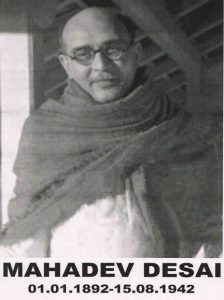
Mahadev Desai Public School
Move Towards Progress
Shri Mahadev Desai
Gandhi made many men and they in their turn made the Mahatma what he was. One of these was Mahadev Desai who worked as Gandhi ji’s secretary for 25 years with unmatched devotion and affection.
He was born on 1 january 1892 at the village of Saras in Olpad Taluka of surat district, where his father Haribhai Desai was a school teacher. The family originally hailed from Dihen in the same district. Mahadev lost his mother Jamnaben when he was only seven years of age.
The family belonged to the Anavil Brahmin caste, one of the leading communities of the district. A keen mathematician and an avid reader of Gujrati literature, Hirabhai had great gascination for the Ramayana, the Mahabharata and the Bhagbat Gita, and by sheer hard work and sincerity he rose to become the Principal of a Women’s Training College at Ahmedabad. Mahadev too inherited many of his father’s qualities. At the young age of 13 Mahadev was married to Durgaben in 1905 and later the couple had one son, Narayan.
Mahadev Desai received primary and secondary education at different places like Surat, from where he matriculated in 1906, winning a scholarship for higher education. He joined the Elphinstone College at Bombay in 1907 and graduated form there in 1910. He joined the Law College thereafter and got his LLB in 1913. Throughout this formative period, he was deeply influenced by his teacher at Dihen, Manishankar, a strict disciplinarian and a lover of Enlish language, by Jivanram Vaidyam recounting stories from the Puranas and Upanishads; and by Surbhai, the village doctor, and his musical sessions.
After graduation Mahadev, while working for his livelihood, translated Lord Marley’s On Compromise’ into Gujarati and won the hand some prize of a thousand rupees. This work as later publkished in 1925. He tried to practice law in courts but was not successful, and through his friend Vailkunthlal Lallubhai Mehta secured a job in a Cooperative Bank. But Mahadev soon got tired of the irregularities being practiced there as well as a lot of travelling involved in the job, and left it.
He had already cultivated a taste for reading since his college days, and al through this drab life he made an extensive study of literature in Gujarati, English, Sanskrit, Bengali, Hindi and Marathi. The month of August 1917, when Mahadev left Bank job, proved fateful, as he met Gandhiji on 31 August and found in him his Guru. Hereafter Mahadev as Gandhiji’s secretary moved like a shadow behind him till his death.
After Madadev Desai joined Gandhiji, three important events took place in their life as well as that of the country. These were the Champaran Satyagraha (1917), the Bardoli Satyagraha (1930), and in all these Mahadev actively participated and courted arrest. In 1921 Gandhiji send him to edit Motilal Nehru’s periodical, the Independent, Allahabad, and there too he was arrested and jailed. After his release in January 1923, he returned to Ahemdabad and looked after the editorial work of the Navajivan.
His sharp editorials on the hollowness of 1919 constitutionals reforms and his tirade against the British Government kept up the tempo of the freedom struggle. Between 1924 and 1928 he toured the country with Gandhiji, explaining the silent features of the freedom struggle. He accompanied Gandhiji in 1931 to the Round Table Conference in London. In the Quit India Movement of 1942, he along with Gandhiji was arrested and sent to the Aga Khan Palace for imprisonment, where he died peacefully on 15 August 1942, deeply mourned by the nation and by Gandhiji in particular who now considered himself an orphan.
After 1917 it was of course Gandhiji who profoundly influenced Mahadev Desai. Mainly through his writings Mahadevbhai interpreted Gandhian philosophy. That is why his friend Dr. Verrier Elwin called him “Bapu’s Boswell”. Learned introduction to the English translation of Gandhiji’s ‘Anassakti Yoga’ not only revels Gandhiji’s ideas but his own understanding of Eastern and Western philosophies and religions. He also very affectively wielded his pen to explain some of the basic Gandhian tenets like Hindu- Muslim unity, removal of untouchability, improving the lot of women, promotion of khaddar and cottage industries, labour welfare, need for badic education, freedom for suppressed nationalities and Truth and non-Violence.
He has to his credit scores of articles published in the young India, the Navjivan and the Harijan on a variety of subjects from ‘Garud-Puran’ to the British policy in India. Due to his profound scholarship, clarity of mind, lucid dairy with meticulous details has given eight voluminous works, published after his death, called ‘Mahadevbhai’s Dairy’.
His original works either in English or in Gujrati include: ‘With Gandhi in Ceylon’ (1928); ‘The Story of Baardoli’; swadeshi-True and False; Unworthy of Wardha’; ‘Eclipse of Faith’ (1929); The Nation’s Voice’ (1932); The Epic of Travanancore’ (1937); ‘Gandhi Sevva Sangh’ and ‘Maulana Abul Kalam Azad’ (1940); ‘Kheti ni Jamin’ ( Gujarati, 1942); and ‘The Geeta according to Gandhi’ (1942); and The Geeta according to Gandhi’ (1946).
His other Gujarati works are on ‘Veer Vallabhbhai’ , a biography of Khan Abdul Ghafar Khan in ‘Khudal Khidmatgar’, ‘Ek Dharmayuddha’ and ‘Sant Francis Xavier nun Keevancharitra’. His transalation include those from English and Bengali: ‘Satyagraha ni Maryada’ (a translation of Morley’s ‘On Tagore’s ‘Prachin Sahitya’, ‘Chitrangada’ and ‘Viday abhishap’). Mahadev Desai presided over the twelfth Gaujarati Journalists ‘Conference.

Copyright © Mahadev Desai Public School
Created By Sudofire